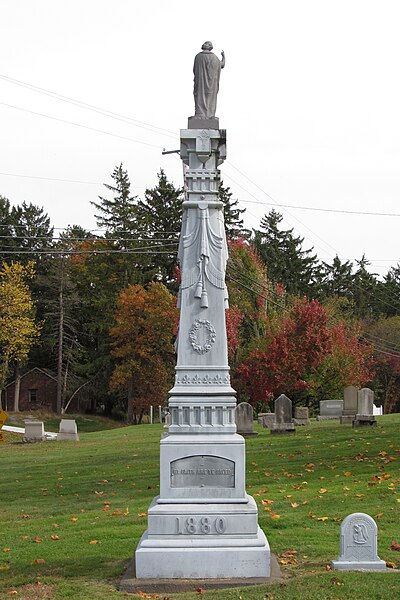
A tower of zinc with a number of stock inserts, but also what appears to be a portrait of one of the deceased—something old Pa Pitt hasn’t seen on other zinc monuments around here.


Hier ruhet Philip, sohn von Philip und Regina Brandt, geboren 1, Nov. 1857, gestorben 7, Aug. 1879. Seine Seele gefiel Gott, darum eilte er mit ihm aus diesem Bösen leben.
Father Pitt’s translation is based on his limited knowledge of Cemetery German, and he invites corrections:
Here lies Philip, son of Philip and Regina Brandt, born Nov. 1, 1857; died Aug. 7, 1879. God was pleased with his soul, so he took it with him out of this evil life.

If you were wondering which allegorical figure the statue on top was supposed to be, you will find it helpfully identified as Faith on the base of the monument.



This portrait might represent Philip Brandt Senior; the man is certainly older than the 21 years that Philip Junior was allotted.
Portraits were a service offered by the Monumental Bronze Co. of Bridgeport, as an 1882 catalogue tells us: “We are prepared to produce correct pictures of individuals in the shape of medallion portraits, half, three-quarter or life size, which we can model from seeing photos or the living subject, having competent artists employed at our works, who are also skillful in producing portrait busts and life size portrait statues.”
From the catalogue, we can identify the monument as the Monumental Bronze Company’s No. 155, which the catalogue mentions can be fitted with “life size Medallion Portraits.” The top of the monument has been replaced with the No. 176 Statue of “Faith”.

By the time the parents died in the early 1900s, their inscriptions were placed in English, perhaps by surviving children who no longer spoke German.

Although zinc monuments ceased to be made at the time of the First World War, inserts for them could still be ordered for some time afterward.

The date 1880 would refer to the erection of the monument, put up shortly after Philip Brandt the younger died in August of 1879.

There are two small headstones beside the main monument: one for Philip Brandt (presumably the same Philip for whom the main monument was erected) and Christena A. Brandt, a girl who died at the age of 11. Youth may die, as the motto in zinc reminds us.

Christena A. daughter of P. and R. Brandt, died April 28, 1866, at the age of 11 years. Farewell all ye earthly friends.
Christena’s inscription is in German, but the standard back panel for the headstone is in English.


The back of Philip’s monument is a gesture equally understood in English or in German.













